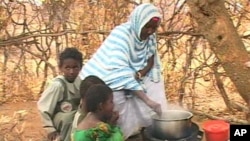The Dadaab Refugee Camp in Kenya is the world's largest refugee settlement, home to almost 300,000 people who have fled the war in neighboring Somalia. The camp is located in an area of Kenya where pastureland, water and other resources are at a premium, and many Kenyans in the surrounding community resent the refugees and their use of local resources. Conflicts between the two groups erupt periodically, and to ease tensions, aid agencies have sponsored income-generating projects in the town of Dadaab.
Firewood, pastureland and water are like gold in this area of northeastern Kenya. Local pastoralists rely on the land for their livelihoods.
Meanwhile, in neighboring Somalia, warfare and hunger are the norm. And those fleeing the turmoil stream into Dadaab Refugee Camp and other parts of Kenya to escape the misery.
Almost 300,000 refugees live in the camp. Some have been there for decades. The nearby town of Dadaab is home to around 30,000 Kenyans, mostly of Somali descent.
Dadaab Acting District Commissioner Bernard Ole Kipury says Kenya has a moral obligation to help the refugees, but he says their presence has a noticeable impact on the local economy.
"There has been a lot of depletion of resources, especially water and pasture, because the refugees come with livestock, they come with large herds of livestock, so this creates competition between the host communities and the refugees because of the limited availability of pasture, which both are now competing for," he said.
Kipury says that puts the refugees and local Kenyans in conflict, especially during times of drought.
For their part, many refugees say they are desperately poor and do not receive enough food and other supplies.
"The only way out of this is for refugees to get everything they need in the camp," said Abdi Noor Osman, who has lived in Dadaabe Refugee Camp with relatives for almost two years. "But if they cannot get what they need here, there will be no peace. For people not to leave the camp, they must have their needs met in the camp."
To ease resentments within the local community, aid groups and the United Nations have set up income-generating projects in and around Dadaab town.
"I think it [income-generating program] will allow the host community to be more self-sufficient and not rely on trying to oppose the refugees," said Richard Floyer Acland, who is head of the United Nations' Refugee Agency's local office. "It will remove some of the tensions between the agencies and the host communities as well as the feeling that everything is being given to the refugees and nothing to them."
One project provides funds and support for shops run by two women's groups. Fatma Sheikh Mohammed Hassan is a Kenyan of Somali descent. She says she is happy that it is not just the refugees who are getting support.
"We benefited very much from the money we were given. The little that the host community is being given is helping," she said. "We built shops, we paid school fees for our children, and we benefited so much."
But more and more refugees are seeking sanctuary in northern Kenya, putting greater pressure on local communities.
The United Nations' Richard Floyer Acland says the Dadaab Refugee Camp expands by about 5,000 people each month, with the new arrivals having to find a place to live on the existing grounds.








